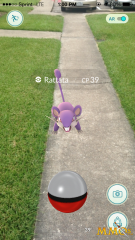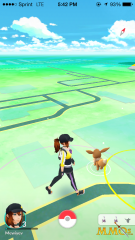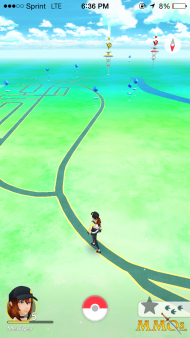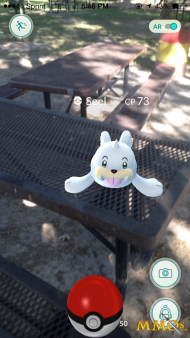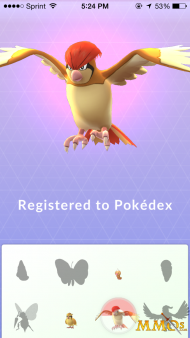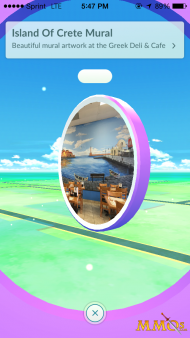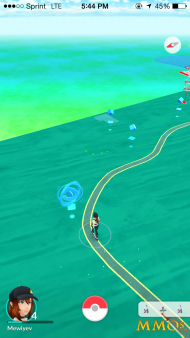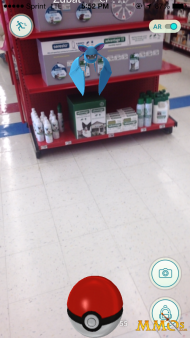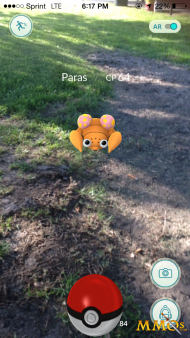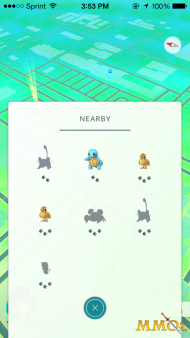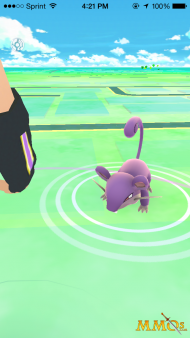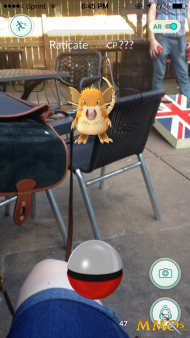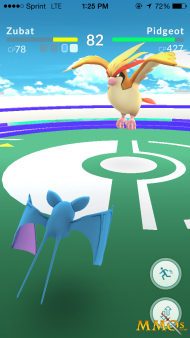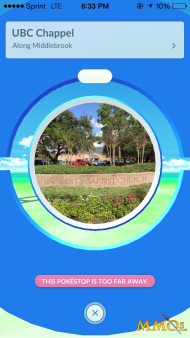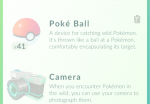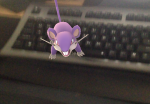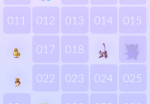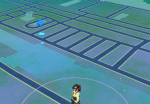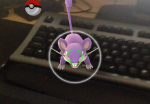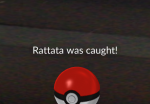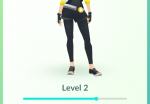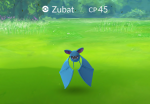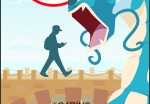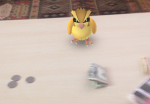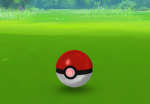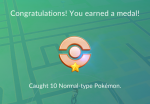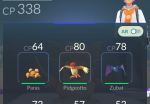Pokemon GO
Pokémon GO is an augmented-reality game for iOS and Android that allows players to capture, battle, and train Pokémon that appear throughout the real world. Stop at Pokéstops to collect items and eggs, or challenge Pokémon gyms across the world and claim them for your faction.
| Publisher: Niantic Playerbase: High Type: Mobile Augmented-Reality MMO Release Date: July 6, 2016 Pros: +Unique AR gameplay. +Variety of collectible Pokémon. +Large playerbase. Cons: -Unstable servers. -No player-to-player battles. -Pokémon dependent on region. |
Pokémon GO Overview
Pokémon GO is a mobile free-to-play augmented-reality MMO that turns the real world into a place where Pokémon roam freely, ready to be caught by intrepid trainers. Explore the world around you and watch your trainer follow your steps on a GPS-enabled map, using the radar to search for the Pokémon closest to you or visit local landmarks called Pokéstops for item rewards. Catch the original 150 Pokémon to fill your Pokédex with the game's unique capturing mechanic, requiring players to properly time and throw Pokéballs at enemy Pokémon while they attack and dodge you. Boost and evolve your captured and hatched Pokémon to create increasingly stronger Pokémon to challenge gyms. Once players reach level 5, they can choose from one of three factions: Team Instinct, Mystic, and Valor, each with their own color and reason for battling Pokémon. After picking a team, players can challenge or defend Pokémon gyms to boost their faction's prestige and take down opposing factions. Pokémon battles occur when players challenge gyms, utilizing swiping and tapping to dodge and attack enemy monsters as opposed to the RPG-style combat of the main series of games.
Pokémon GO Key Features:
- Pokémon in the Real World – leave your handheld game system behind, using your phone to track and capture Pokémon as if they were living creatures.
- Three Player Factions – represent Team Instinct, Mystic, or Valor in local gyms to boost your prestige and increase your team's power.
- Challenge and Defend Gyms – fight enemy players' Pokémon in gyms and defend your own team's gym by placing your Pokémon in it.
- Hatch, Catch, and Evolve Pokémon – acquire Pokémon from capture or from eggs, then use candies to evolve them into their next evolution for stronger stats.
- Visit Pokéstop Landmarks – set out in your town to search for Pokéstops that are featured on random landmarks and spin the circle to acquire new items.
Pokémon GO Screenshots
no images were found
Pokémon GO Featured Video
Pokémon GO Review
Pokémon GO is the first game to make headlines because players are going outside. Hundreds of people circle suburban parks, using their hands to block glare in search of Charmander. And the strangest part is players are talking to each other. I’ve chatted with more strangers in the last two weeks than my entire life thanks to the ice-breaker, “You’re playing Pokémon Go too?” Who knew so many people could make small talk over catching virtual creatures? I didn’t. Nor would I have ever expected it.
Go is a phenomenon unlike anything else, an app that’s attractive because of the interactions off-screen; it’s the players, not the game, that have generated endless buzz.
But if you cut out all of the small chats, long walks, and movie dates because two people sitting across from each other locked eyes on the same Pokémon, you’re left with a shallow game: an addictive shallowness: the only kiddy pool on a day pancakes sizzle on the sidewalk. There’s not much to offer but you can’t resist dipping your feet in the water. I’ve never been this consistent wearing pants.
The Core Phenomenon
Pokémon Go’s gameplay is simple. It uses your GPS to render your immediate surroundings as a colorful map on your phone. Your character is a tiny avatar that will move where you move, and as you walk around Pokémon have a chance of popping into existence. Click a Pokémon and the camera zooms in. It’s not a battle. No need to sap away health until hospice gives you a business card. Clicking a ball creates a colored circle that traces on top of the Pokémon—a minigame, a dynamic Cornhole. Get the ball in the circle and you get a prize: an animal stuffed in a claustrophobic cage.
The target retraces towards a point; throw a Pokeball inside the circle for a bonus: the smaller the circle the more experience. Circles also come in different colors, indicating how difficult the catch will be. Green is easy; red is hard. Simple mobile gameplay, perfect for goofing off at work in 30 second intervals.
Go’s gameplay is more real-world Safari Zone than traditional Pokémon—wish I could throw a rock at Zubats.
Swiping balls at monsters is the core game, the first aspect you’ll experience, the thing you’ll do everyday you leave your house for a hunt. It’s okay, oddly cathartic. I wandered the streets of my Leave it to Beaver suburbia collecting every Weedle, Pidgey, and Ratata. I didn't stop until I ran out of Pokeballs and felt tranquil and sore. Catching Pokémon is so simple, so stupid simple. But I was addicted. It's euphoric and I’m not surprised to hear that people with depression and anxiety are feeling relief thanks to Go.
Augmented Reality?
When zoom in on a Pokémon the creature appears in your immediate environment. If you're having brunch at KFC, Pidgey will sit on 12-piece fried chicken. The game superimposes Pokémon on whatever your camera sees. The superimposition is not true AR as what you see isn't affected by your actions in reality, beyond flinging a virtual ball. And while it's also a gimmick Pokémon Go's mingling of the real world and the virtual is neat. Ultimately I turned it off as catching Pokémon is far easier on a rendered background. Still cool. And some players have taken neat screenshots thanks to the system.
Pokémon PhD
Pokémon Go lacks a formal tutorial. A few words from Professor [Stylish] and you’re off on your adventure. Some players lament sparse information but I love it. Revealing clues at a drip motivates players to communicate, to stop someone at a Lure and say, “hey do you know where I can find Mr. Mime?” Or, “yo, my man what's up with the petals scattered under this PokeStop?”
Message boards are brimming with posters trying to scrap together every detail of Go to unravel its Easter eggs. Some forums are dedicated to dissecting stats, revealing how Eevee's evolve, ranking Pokémon by their base attack and defense, and discussing the best spots to farm Pokémon in their areas. The lack of information has turned players into scientists with GO under their microscopes, looking for how each of the game’s atoms interact with each other.
PokeStops - Or How To Swipe For Rewards
Floating blue cubes called PokeStops sit on the map to designate points of interest, typically benches in a park, local artwork, a cobblestone house George Washington once took a nap in—places of significance. Walk close enough to a PokeStop and the cube becomes a coin you can spin for items. It’s the default way to accumulate Pokeballs, Potions, Razz Berrys, etc. PokeStops are the attractions on Pokémon Go’s map. They provide some direction for your journeys, places to refuel and meet other players.
As a concept PokeStops pose a great way for players to learn about their surroundings, or find out who that bench is dedicated to. “As a concept.” What really happens is a frenzy. You spin stops before the name can load, to earn items and keep moving. No time to read about the comic-book shop Alan Moore once blew his nose in.
But, for observant players PokeStops are interesting. It turns your town into a world imbued with meaning—funny how that meaning derives from a game about collecting monsters because you can’t control your insatiable hunger.
Some places are devoid of PokeStops, especially rural areas, while cities are littered: Central Park is packed. If you live in the country you have no recourse. You have to drive somewhere or give up; Henry David Thoreau couldn’t even find a Spearow. Pokémon Go is going to be enjoyed by people who live in high population density areas while the rest stare at an empty map, no Pokémon in sight.
Lures All Day
PokeStops can also be hotspots for Pokémon if a player uses an item called a Lure on the stop. You’ll know a lure is activated because Starburst pink petals swirl a the stop. They attract Pokémon for 30 minutes—great if you’re going to sit in one place. And every player sees an activated lure, honey for players to stick around.
Hundreds of people zombied back and forth on a bike trail where six lures had been activated. All staring at their phone; all getting excited when Squirtle popped; all sharing the experience. I talked with many of them, discussing the game, sharing secrets, and spots in the area to find Dratini.
Heading to a Lured up PokeStop and finding other people who are just as engaged as you is unprecedented. Go tears down the LCD veil that creates distance between people, the artificial barrier that dehumanizes an online commentor expressing his love for Vulpix. I can see other players. I can see their passion, feel the shared immersion, like entering an MMO and seeing hundreds of players also doing newbie quests—validating your own time in the game and motivating you to keep going.
Psh Tall Grass, Stay In The City
Go is disingenuous to its franchise predecessors. When you play Pokémon on Gameboy you venture into tall grass, caves, glide across seas on the back of a Lapras sprite symbolizing all of your water Pokémon in search of rare creatures. You venture into the wild, brave the elements, test yourself. But Pokémon Go teaches you to hang out in alleyways, outside the Verizon store, and in oversized suburban malls. Mountains, streams, and Area 51, are Pokémon wastelands. Why? I mean I know why, it’s because Go is largely built off of cellular data, But hikers ought to be rewarded for their six-mile trek. Maybe Nintendo is trying to tell us to enjoy ourselves when we’re actually in nature, and to play Pokémon when running errands.
Eat More Candy!
The mainstay of Pokémon is evolving cuddly creatures towards their ferocious final forms: Nidoran♂ to Nidoking; Squirtle to Blastoise; Caterpie to Butterfree (maybe not ferocious in all cases). In traditional Pokémon games you battle your Pokémon to level them up and evolve. But since there’s no trainer battles in Go players fatten up their stock to force an evolution.
Rather than experience, Pokémon evolve through candies. Each Pokémon has their own candy, e.g. , Caterpie candy, Poliwag candy, etc. Get enough candy and you can evolve your Pokémon: to evolve Pidgey into Pidgeotto you need 12 Pidgey candies, and from Pidgeotto to Pidgeot, 50 (Pokémon in the same evolutionary chain use the same candies). But you have to stuff 400 candies into Magikarps floppy body to make him useful as Gyarados. Each evolutionary chain has their own demands.
Catching a Pokémon rewards three candies for that specific one—catch a Pidgey, earn three Pidgey candies. Or you can transfer Pokémon for a single candy, at the cost of losing that Pokémon. But losing Pokémon is okay. You want to have dozens of Rattatas because you’ll end up transferring a lot.
Thanks to the way evolution works Pokémon Go turns players into Pokémon breeders. After a day of catching Pokémon you transfer weaker monsters in a repetitive swiping and clicking motion; my legs get a workout and so do my thumbs. A limited storage facility (250 by default) means you can’t hoard em’ all. So you sit there and transfer, transfer, transfer to either evolve one Pokémon or raise another Pokémon’s power level with some vitamin-fueled candy.
The system is okay, a bit lackluster, but not in harmony with what longtime Pokémon fans have come to expect. Candy-evolving works for a simple mobile game. It’s enough to give evolution some longevity because it takes time to turn Charmander into Charizard, and a lot of Charmanders. Candy evolution becomes problematic for the hardcore levelers.
XP Plz
For nearly every action you gain experience: catch a Pokémon, experience; spin a PokeStop at Panucci’s Pizza, experience; evolve a Pokémon, experience. New players level just by participating in the game. Walking around a lake catching a nest of Rattatas and wagging slurs at players on opposing teams creates a real sense of progression. All you have to do is get outside. It’s in-your-face leveling, immediately evident as you stare at your screen hoping for rare Pokémon to pop. And the higher the level, the stronger the Pokémon.
The Min/Max Debacle
You want to level fast to catch up to the teenager that yelled “scrub” from the car circling the park? Well I hope you like grinding. Instead of being a Pokémon Trainer you got to be an immoral breeder, an insensitive scientist who feeds the remains of Pokémon’s past to level fast.
Optimal leveling means stocking up on any Pokémon that takes 12 candies to evolve (the cheapest ones): Pidgey, Weedle, and Caterpie, because evolving is an easy 500 experience, combined with an experience boosting Lucky Egg you get by leveling from the cash shop that becomes 1000 experience. So you evolve Pokémon individually over the course of a half-hour, gaining the maximum amount of experience possible. Since Lucky Eggs last 30 minutes and you have to watch the evolution animation each time, you can roughly gain around 50,000 experience per level, or the amount of experience needed to go from 20 to 21.
You have to sit there and plan out which Pokémon you’re going to evolve, calculating how many Weedles to burn down to hit the maximum number of Kakunas. Got to be set up before you pop the Lucky Egg. Of course you don’t have to play obsessively. But leveling up is desirable.
Higher levels mean stronger Pokémon spawn, so transfer-grinding is an almost demanded strategy for players who feel the need to compete. And by “compete” I mean players who want to look cool to random strangers or feel peer pressured by friends without obligations, “Yeah nice 3000 CP Dragonite Michael (I resent you’re free-spirited–non-committal lifestyle Michael).”
If Go was a game about any other franchise players would not tolerate the monotony of transferring Pokémon.
It’s a bit baffling that the optimal leveling experience revolves around tedious tasks. You sit on your phone and tap into each Pokémon, scroll down, click transfer, wait for the game to load, and repeat the process until you’ve earned enough candies to evolve. That isn’t Pokémon. At least, not the Pokémon fans know. You’re the newest employee at the Daycare Center and you’re going to make Pokémon stronger like fairy tale witch—cook em into candy and make German Pokémon eat them. Candy leveling is mediocre, but I can’t help doing it, even while recognizing how bland the process is.
Pewter Badge Troubles
The only engagement between players within the game is through Gyms; the only way to battle is a passive interaction. Gyms are scattered on the game’s map, like PokeStops they designate points of interest. Go’s three rivalry-used-for-an-excuse teams trade gyms like the village pony.
Smack-talk between players is fun, not the combat.
At level 5 players choose between three rivaling teams: Mystic, Valor, or Instinct—each represented by one of three colors: blue, red, or yellow respectively. The internet is a dump of memes in support and antagonism for each faction. Great fun. Rivaling teams trade light-hearted insults as they trade gyms back and forth. “What team are you?” “Team Blue.” “Team Valor for life suckers,” as the car drives away. Why are we fighting? Who cares. Healthy competition breathes life into the game, gives people an excuse to talk as they tap away.
Not Your Childhood Battles
Battles are lame.
Engaging a gym is nothing like the traditional games. It’s an active tap-combat system. You choose six Pokémon to fight the gym Pokémon. Every Pokémon has two moves, a primary and secondary. You use the first move by tapping on your phone’s screen which builds a special bar to your ultimate. Battles end up being tap,tap,tap hold—tap, tap, “I win!”
Pokémon can also dodge by swiping left and right, if your phone is behaving. Most times dodging falls flat: unresponsive to swipes so you’re left tapping for victory.
You’re fighting another trainer’s Pokémon but AI is fighting, not the player. There is no player-to-player battles, which may be due to network issues or data usage worries. Whatever the issue it doesn’t look like Pokémon Go will be adding real-time PvP. But if you beat the stationed Vaporeon the gym is yours, and you’ll choose one Pokémon to act as a sentry and defend the gym from other teams.
You can only station one Pokémon at a gym. To build up the gym’s defense you’ll need other players wearing the same stripes to station their own Pokémon. Go encourages you to form roaming bands of like minded warriors, to take gyms together. You have to socialize for the sake of virtual gang allegiances. While the battles fall flat, the experience of working together to pummel other teams is both hilarious and rewarding.
At a community lake near my house cars pull up to a gym all night, battling for the right to have their Pokémon stand triumphant. It constantly changes hands as kids and adults cheer and jeer, swapping the gym between themselves. And they have a reason to be excited. Holding a gym gives you bragging rights and cash shop points.
Gotta Pay To Catch Em All
Pokémon Go’s cash shop is innocuous enough. It’s exclusives are reasonable and avoid motivating legions to hold protest signs proclaiming “pay-to-win.” Almost everything in the shop is rewarded by leveling, such as Incense and Lures—while Pokeballs drop out of PokeStops, for reasons no one’s dared question.
The key phrase is “innocuous enough.” Because at higher levels you burn through Pokeballs like skipping stones across a pond: throwing them away for the smallest ripple. After level 20 even evolution-leveling fodder like Spearow and Rattata are too strong for Pokeballs. The itch to purchase Pokeballs digs deeper with each level because you can’t walk around the park fast enough to replenish your stock. By 30 even Weedle is jacked up on steroids: smashing through dozens of Pokeballs.
Niantic has chosen to annoy high-level players, the hardcore, rather than pull the usual cash shop shenanigans of motivating new players to spend money to catch up to rivals. It’s fine, and not pay-to-win. It’s pay-to-not-be-annoyed. But the shop needs work. As of this writing only Pokeballs are available for purchase while Great Balls and Ultra Balls can only be gained by visiting PokeStops. A fairer cash shop would offer all three, allowing players who have unlocked higher-tier balls to buy them so that they’re not burning through Pokeballs.
Final Verdict - Good
Go is a game whose value is completely determined by the player’s immediate surroundings. If you aren’t lucky to live in an area of high Pokémon Go players and Pokémon density you will disregard it, forced to watch mobs of people scramble in parks elsewhere in the country because someone said, “Dragonite!” That’s unfortunate. But it doesn’t discount what’s happened. Because Pokémon Go isn’t a game. It’s an activity. Something to do when you call up your friends and say “What do you want to do?” “Pokémon Go bro.” If the franchise Niantic chose wasn’t Pokémon I can’t imagine Go would have widespread success.
Pokémon Go released at the perfect time, when Pokémon is embedded in the cultural framework of the technologically savviest: six year olds to thirty-six year olds.
No, Pokémon Go is not the Pokémon MMO players have wanted. We still have to look to passion projects for traditional Pokémon multiplayer. It lacks player-to-player battles, includes a weird Pokémon breeding game to power up, and fails to be as captivating as the people playing it. But it is a sensation, an unexpected gamechanger.
Sometimes something comes along that expresses our common humanity, something that shows us we can all find interests to relate to. I can’t believe it's Pokémon, and a mobile game. I wonder what people will say in a few years as they look back. Maybe they’ll glance from their phones as they think about 2016 and how Go’s launch was a weird, exciting time. Then they’ll shake off the thought and focus on the wild Tyranitar that just spawned in the park.
Pokémon GO Videos
Pokémon GO System Requirements
Minimum Requirements:
Operating System: Android 4.4 or later / iOS 8.0 or later
Pokémon GO Music & Soundtrack
Coming Soon...
Pokémon GO Additional Information
Developer: Niantic
Publisher: Niantic, The Pokémon Company, Nintendo
Platforms: iOS, Android
Beta Date (Japan): March 2016
Beta Date (AUS, NZ): April 7, 2016
Beta Date (US): June 16, 2016
Release Date (US, AUS, NZ): July 6, 2016
Go Plus Release Date: July 31, 2016
Development History / Background:
Pokémon GO is developed by Niantic, a US-based software development company known for its augmented reality game Ingress, formed from Google as an independent entity in October 2015. The game is co-published by Niantic, The Pokémon Company, and Nintendo, which were announced to be working together in September 2015. The idea for the game was originally conceived in 2013 for an April Fools' Day collaboration with Google called the Pokémon Challenge. The game's beta began in Japan in March 2016, eventually opening up to many other countries in the world by July 2016. It was released on July 6, 2016 in the United States, Australia, and New Zealand, and saw a delayed release in other regions due to the high server strain. Features such as Pokémon trading and improvements to gyms and stops are coming in future updates.
The game was developed alongside a small device titled the Go Plus which alerts players to nearby Pokémon with a vibration without having to have their phone out, which was chosen over a smartphone app that is believed to be too cost prohibitive for most users. The Go Plus is set to release on July 31, 2016.
